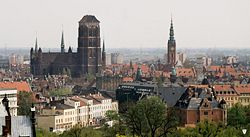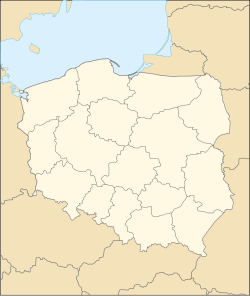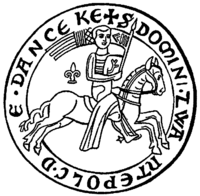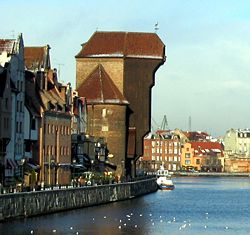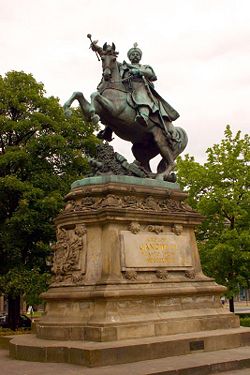Gdansk
| Gdańsk | |||
| Gdańsk Old Town | |||
|
|||
| Motto: Nec Temere, Nec Timide (Neither rashly, nor timidly) |
|||
| Coordinates: 54°22′N 18°38′E | |||
|---|---|---|---|
| Country | |||
| Voivodeship | Pomeranian | ||
| County | city county | ||
| Established | 10th century | ||
| City rights | 1263 | ||
| Government | |||
| - Mayor | Paweł Adamowicz (PO) | ||
| Area | |||
| - City | 262 km² (101.2 sq mi) | ||
| Population (2009) | |||
| - City | 455,830 | ||
| - Density | 1,739.8/km² (4,506.1/sq mi) | ||
| - Metro | 1,080,700 | ||
| Time zone | CET (UTC+1) | ||
| - Summer (DST) | CEST (UTC+2) | ||
| Postal code | 80-008 to 80-958 | ||
| Area code(s) | +48 58 | ||
| Car plates | GD | ||
| Website: http://www.gdansk.pl | |||
Gdańsk is situated in northern Poland on the southern edge of Gdańsk Bay off the Baltic Sea, and is the central city within the fourth-largest metropolitan area in Poland. It is the largest city in the Pomerania region and the capital of the Pomeranian Voivodeship. Its location at the mouth of the Motława River gives the city a unique advantage as the center of Poland's sea trade and the country's principal seaport.
Gdańsk is an important seaport and shipbuilding center. Historically it was a member of the Hanseatic League, and remains an important industrial center. In modern times Gdansk was the birthplace of the Solidarity movement which, under the leadership of political activist Lech Wałęsa, played a major role in bringing democracy to Poland and an end to communist rule across Central Europe.
Etymology
The city's name is thought to originate from the Gdania river, the original name of the Motława branch on which the city is situated. The diacritic over the "n" is frequently omitted by non-Poles. In the local Kashubian language it is known as Gduńsk.
Like many other Central European cities, Gdańsk has had many different names throughout its history. The Germanized version of this name, Danzig, has been used by the German population, as well as in English until the end of World War II. Other former English versions of its name include Dantzig, Dantsic, and Dantzic. The city's Latin name may be given as either Gedania, Gedanum or Dantiscum; the variety of Latin names reflects the mixed influence of the city's Polish, German and Kashubian heritage.
Geography
The city lies on the southern edge of Gdańsk Bay (of the Baltic Sea), in a conurbation with the spa town of Sopot, the city of Gdynia and suburban communities, which together form a metropolitan area called the Tricity (Trójmiasto). They are situated adjacent to one other, in a row, on the coast of the Gdańsk Bay. The three cities are located in a weather protected harbor favored by the Hel Peninsula.
The Old Town area of Gdansk is situated two miles (three kilometers) inland at the mouth of the Motława River, connected to the Leniwka, a branch in the delta of the nearby Vistula River, whose waterway system waters 60 percent of the area of Poland and connects Gdańsk to the national capital in Warsaw. This gives the city a unique advantage as the center of Poland's sea trade.
Gdansk enjoys a temperate maritime climate, with cold, cloudy, moderately-severe winters and mild summers with frequent showers and thunderstorms. Winter lasts from December to March and includes periods of snow. Summer, which begins in June, is predominantly warm but hot at times, up to 95°F (35°C), with plenty of sunshine interspersed with heavy rain. The average maximum daytime temperature in January of 34°F (1.1°C), rising to an average maximum of around 70°F (21°C) in July. The average annual precipitation in Gdańsk is about 23.6 inches (600 mm).
History
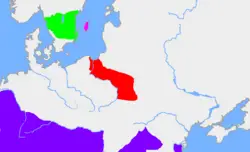
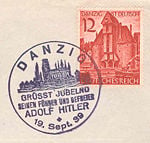
Stone Age, Bronze Age, and Iron Age cultures occupied the area around the Vistula delta. Settlements existed in the area for several centuries before the common era. In the first century C.E., the Wielbark culture, widely identified as the Gothiscandza (or Coast of the Goths) that was mentioned by the Roman historian Jordanes in the sixth century, appeared in the area. It was characterized by Scandinavian burial traditions, such as the stone circles. In the third century, this culture moved to the Ukraine. East Germanic and Baltic tribes controlled the area and traded with the Roman Empire until around 500 C.E.
Pomeranians migrated to the area, while they settled in neighboring areas in Pomerania with the general Slavic people's movement to the north and west from the Pripjet marshes after 600 C.E. There are traces of a crafts and fishing settlement from the eighth to ninth centuries.
Mieszko I of Poland (935–992) built a stronghold at Gdańsk in the 980s, after a series of wars against the local tribes, an event regarded as the founding of Gdańsk. In 997, Saint Adalbert of Prague baptized the inhabitants of the settlement on behalf of Boleslaw the Brave of Poland. In 1186, a Cistercian monastery was set up in Oliva nearby (now within the city limits).
Gdańsk in 1215 became the main burgh of a Pomerelian splinter duchy. In 1224-1225, Germans in the course of the German eastward expansion established Danzig in the area of the earlier fortress. In 1226, the town was granted, by Swantopolk II (1200–1266), an autonomy charter similar to that of Lübeck. Danzig gained great importance in the Baltic area as a city of merchants and trade and as a port city. While at this time the surrounding lands were inhabited by Pomeranians, Danzig became a starting point for the German settlement of the largely fallow Vistula land.
In 1308, the Teutonic Knights seized the city, and held it until 1466, when King Casimir IV (1427–1492) of Poland regained the territory after a 13-year war. The city thrived as a result of increased exports of grain (especially wheat), timber, tar, and other forestry goods from Poland via the Vistula River trading routes. German migration increased, and the city became a full member of the Hanseatic League in 1361.
Granted local autonomy, Gdańsk expanded greatly, after gaining free and privileged access for the first time to Polish markets, and trading with the other Hanseatic cities. King Stephen Báthory (1533–1586) besieged the city in 1577 for six months, and defeated the city's army of 5,000 mercenaries in a field battle on December 16, 1577. However, since Stephen's armies were unable to take the city by force, Stephen Báthory confirmed the city's special status and Danzig Law privileges granted by earlier Polish kings.
The Swedish wars of the 17th century stalled the city’s economic growth. It was taken by the Russians after the Siege of Danzig in 1734. By 1754, Danzig had a population of 77,000, the largest of any eastern European city, and annual grain exports of more than 200,000 tons.
Danzig was annexed by the Kingdom of Prussia in 1793, only to be broken off by Napoleon as a pseudo-independent free city from 1807-1814. Returned to Prussia after France's defeat in the Napoleonic Wars, the city became the capital of Regierungsbezirk Danzig within the province of West Prussia from 1815. The city became part of the German Empire in 1871.
When Poland regained its independence after World War I (1914-1918) with access to the sea as promised by the Allies on the basis of Woodrow Wilson's "Fourteen Points," the Poles hoped the city's harbor would also become part of Poland. However, since a 1919 census determined that the city's population was 98 percent German, it was not placed under Polish sovereignty, but, according to the terms of the Versailles Treaty, became the Free City of Danzig, an independent quasi-state under the auspices of the League of Nations with its external affairs largely under Polish control. This led to a large degree of tension between the city and the surrounding Second Republic of Poland. The Free City had its own constitution, national anthem, parliament, and government. It issued stamps and currency. Poland built another port on Polish territory at Gdynia, 10 miles (16 km) to the north, which grew rapidly.
In the early 1930s the local Nazi Party capitalized on pro-German sentiments and in 1933 garnered 38 percent of vote in the parliament. Thereafter, the Nazis under Gauleiter Albert Forster (1902–1952) dominated the city government, which was still nominally overseen by the League of Nations' High Commissioner. In 1938, Germany’s leader Adolf Hitler (1889–1945) demanded that Danzig be given to Germany. Poland’s refusal was used by Germany as reason for its attack on Poland on September 1, 1939, which precipitated World War II (1939-1945).
That war began in Danzig, with a bombardment of Polish positions at Westerplatte by the German battleship Schleswig-Holstein, and the landing of German infantry on the peninsula. Polish defenders at Westerplatte resisted for seven days before running out of ammunition. Meanwhile, after a fierce daylong fight, defenders of the Polish Post office were shot dead and buried on the spot in the Danzig quarter of Zaspa. The city was officially annexed by Nazi Germany and incorporated into the Reichsgau Danzig-West Prussia.
Most of the Jewish community in Danzig were able to escape from the Nazis before the outbreak of war. However, on the first day of the war, approximately 1,500 ethnic Poles were arrested, and on September 2, 1939, 150 were deported to the Stutthof concentration camp some 30 miles from Danzig, and murdered. Many Poles living in Danzig were deported to Stutthof or executed in the Piaśnica forest.
As the Soviet Army advanced in 1944, German populations in Central and Eastern Europe took flight, resulting in the beginning of a great population shift. After the final Soviet offensive began in January, 1945, hundreds of thousands of German refugees, many of whom had fled to Danzig on foot from East Prussia, tried to escape through the city's port in a large-scale evacuation involving hundreds of German cargo and passenger ships. Some of the ships were sunk by the Soviets. In the process, tens of thousands of refugees were killed.
The city also endured heavy Allied and Soviet bombardment by air. Those who survived and could not escape encountered the Soviet Army, which captured the city on March 30, 1945 and largely destroyed it. In line with the decisions made by the Allies at the Yalta and Potsdam conferences, the city was returned to Poland after 152 years. The remaining German residents fled or were expelled to postwar Germany, and the city was repopulated with ethnic Poles, including many from Polish areas annexed by the Soviet Union who were deported by the Soviets in two major waves from the eastern portion of pre-war Poland.
The historic old city of Gdańsk was rebuilt during the 1950s and 1960s. Boosted by heavy investment in the development of its port and three major shipyards, Gdańsk became the major shipping and industrial center of the Communist People's Republic of Poland.
As part of German-Polish reconciliation policies driven by West German Chancellor Willy Brandt's Ostpolitik, German territorial claims on Gdańsk were renounced, and the city's full incorporation into Poland was recognized in the Treaty of Warsaw in 1970. This was confirmed by a reunited Germany in 1990 and 1991.
In 1970, Gdańsk was the scene of demonstrations which led to the downfall of Poland's communist leader Władysław Gomułka (1905-1982). Ten years later the Gdańsk Shipyard was the birthplace of the Solidarity trade union movement, whose opposition to the Communist regime led to the end of Communist Party rule in 1989, and sparked a series of protests that successfully overturned the Communist regimes of the former Soviet bloc. Solidarity's leader, Lech Walesa, a native of Gdańsk, became President of Poland in 1990. Gdańsk native Donald Tusk became Prime Minister of Poland in 2007.
Government
Poland is a republic in which the chief of state is a president elected by popular vote for a five-year term, and eligible for a second term. The president appoints the prime minister, deputy prime ministers, and cabinet, according to the proposals of the prime minister, who is typically from the majority coalition. The Polish Parliament has two chambers. The lower chamber (Sejm) has 460 members, elected for a four-year term by proportional representation. The Senate (Senat) has 100 members elected for a four-year term.
Contemporary Gdańsk is the capital of the province called the Pomeranian Voivodeship and is one of the major centers of economic and administrative life in Poland. Many agencies of the state and local government have their main offices there, including the provincial government, the ministerial agency of the state treasury, the court of appeal, and the high administrative court, among others.
Economy
Poland has pursued a policy of economic liberalization since 1990 and today stands out as a success story among transition economies. GDP per capita, at $16,200 in 2007, remained below the European Union average, but is similar to that of the three Baltic states. An inefficient commercial court system, a rigid labor code, bureaucratic red tape, and persistent low-level corruption keep the private sector from performing up to its full potential.
The industrial sections of Gdansk are dominated by shipbuilding, petrochemical and chemical industries, and food processing. The share of high-tech sectors such as electronics, telecommunications, IT engineering, cosmetics, and pharmaceuticals is on the rise.
Amber processing is also an important part of the local economy, as the majority of the world's amber deposits lie along the Baltic coast.
The Pomeranian Voivodeship, including Gdańsk, is also a major tourist destination in the summer months, as millions of Poles and European Union citizens flock to the beaches of the Baltic coastline. Gdansk is often the setting for open air concerts.
There is a good rail connection with all Polish cities, and with the neighboring Kashubian Lakes region. The Obwodnica Trojmiejska is an expressway that bypasses the cities of Gdynia, Sopot, and Gdańsk. The A-1 Highway to connect the port and city of Gdańsk with the southern border of the country was under construction in 2008. The Szybka Kolej Miejska is the urban transportation service of Tricity. The Gdańsk Lech Wałęsa Airport is the city's international airport.
Gdansk has two main port areas. The older Nowy Port (New Port) has shipyards, metallurgical and chemical plants, timber mills, and food-processing plants. The newer Port Północny (North Port) handles coal exports and petroleum imports, processed at a nearby refinery.
Gdańsk is the starting point of the EuroVelo 9 cycling route which continues south through Poland, then into the Czech Republic, Austria and Slovenia before ending at the Adriatic Sea in Pula, Croatia.
Demographics
Gdańsk itself has a population of 458,053 (2006), making it the largest city in the Pomerania region of Northern Poland. Poles made up 96.7 percent of Poland's population in 2002, German 0.4 percent, Belarusian 0.1 percent, Ukrainian 0.1 percent, other and unspecified 2.7 percent. The Polish language was spoken by 97.8 percent. Roman Catholics make up 89.8 percent (about 75 percent practicing), Eastern Orthodox 1.3 percent, Protestant 0.3 percent, other 0.3 percent, unspecified 8.3 percent.
Gdansk has 14 universities with a total of 60,436 students, including 10,439 graduates as of 2001. These include: Gdańsk University, Gdańsk University of Technology, Medical University, the Academy of Physical Education and Sport of Gdansk, the Musical Academy, and Arts Academy, among others.
Places of interest
The city has many fine buildings from the time of the Hanseatic League. Most tourist attractions are located along or near Ulica Długa (Long Street) and Długi Targ (Long Market), a pedestrian thoroughfare surrounded by buildings reconstructed in historical (primarily seventeenth century) style and flanked at both ends by elaborate city gates. This part of the city is sometimes referred to as the Royal Road as the former path of processions for visiting kings. Sites of interest include:
- Żuraw, the mediaeval port crane often pictured as a symbol of Gdańsk, was built between 1442 and 1444, when Gdansk was a Polish city.
- Golden Gate, which was raised in 1612–14 in place of the thirteenth century Gothic gate Brama Długouliczna, and is located at one end of Long Lane
- Long Lane, which leads from Golden Gate to Long Market and Green Gate.
- Sites on or near the Royal Way include: Upland Gate, the Torture House, the Prison Tower, Long Street, Uphagen House, Main Town Hall, Long Market, Arthur's Court, Neptune Fountain, Golden House, and Green Gate.
- St. Mary (Bazylika Mariacka), a municipal church built during the fifteenth century, is the largest brick church in the world. Gdańsk has a number of historical churches, which include: The churches of St. Bridget, St. Catherine, St. John, St. Nicholas, and the Church of the Holy Trinity.
- The museum ship Soldek is anchored on the Motława River.
Looking to the future
Gdańsk is both an important cultural seat and industrial center. It is home to schools of medicine, engineering, fine arts, and museums. The city has many fine architectural examples of buildings from the time of the Hanseatic League. It is also home to many beautifully constructed churches. Culture is played out in theaters, a concert hall and an opera house.
The location of Gdansk gives the city a unique advantage as the center of Poland's sea trade. It is the nation's principal seaport and an an important European industrial center. Gdańsk is a leading worldwide ship building center and major shipping port. Its multitude attractions make it an important cultural, industry, and tourist destination.
ReferencesISBN links support NWE through referral fees
- Biskupski, Mieczysław B. 2000. The History of Poland. The Greenwood histories of the modern nations. Westport, CN: Greenwood Press. ISBN 9780313305719
- Depta, Ryszard, Stanisław Klimek, and Lech Krzyżanowski. 1999. Gdańsk: Architecture and History. Wrocław: VIA. ISBN 9788386642403.
- Gdansk. 2007. Cityspots. Peterborough: Thomas Cook. ISBN 9781841576268.
- Persky, Stan. 1981. At the Lenin Shipyard: Poland and the rise of the Solidarity Trade Union. Vancouver, BC: New Star Books. ISBN 9780919888456.
- Singer, Daniel. 1981. The Road to Gdansk: Poland and the U.S.S.R. New York: Monthly Review Press. ISBN 9780853455684.
- Tighe, Carl. 1990. Gdańsk: National Identity in the Polish-German Borderlands. London: Pluto Press. ISBN 9780745304748.
- World Fact Book. 2008. Poland.
External links
All links retrieved April 17, 2024.
- (Polish) Virtual Gdańsk (portal)
Credits
New World Encyclopedia writers and editors rewrote and completed the Wikipedia article in accordance with New World Encyclopedia standards. This article abides by terms of the Creative Commons CC-by-sa 3.0 License (CC-by-sa), which may be used and disseminated with proper attribution. Credit is due under the terms of this license that can reference both the New World Encyclopedia contributors and the selfless volunteer contributors of the Wikimedia Foundation. To cite this article click here for a list of acceptable citing formats.The history of earlier contributions by wikipedians is accessible to researchers here:
The history of this article since it was imported to New World Encyclopedia:
Note: Some restrictions may apply to use of individual images which are separately licensed.
